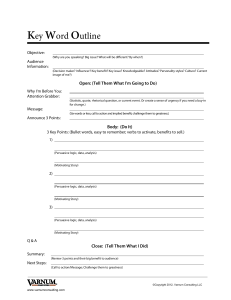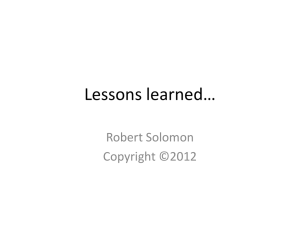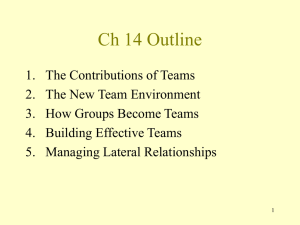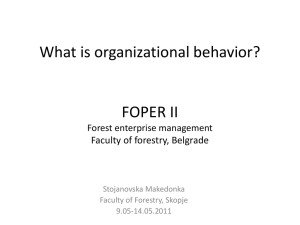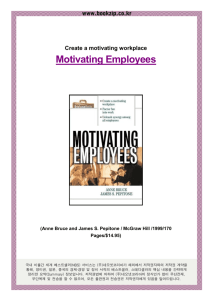Managing People for Organizational Success
advertisement
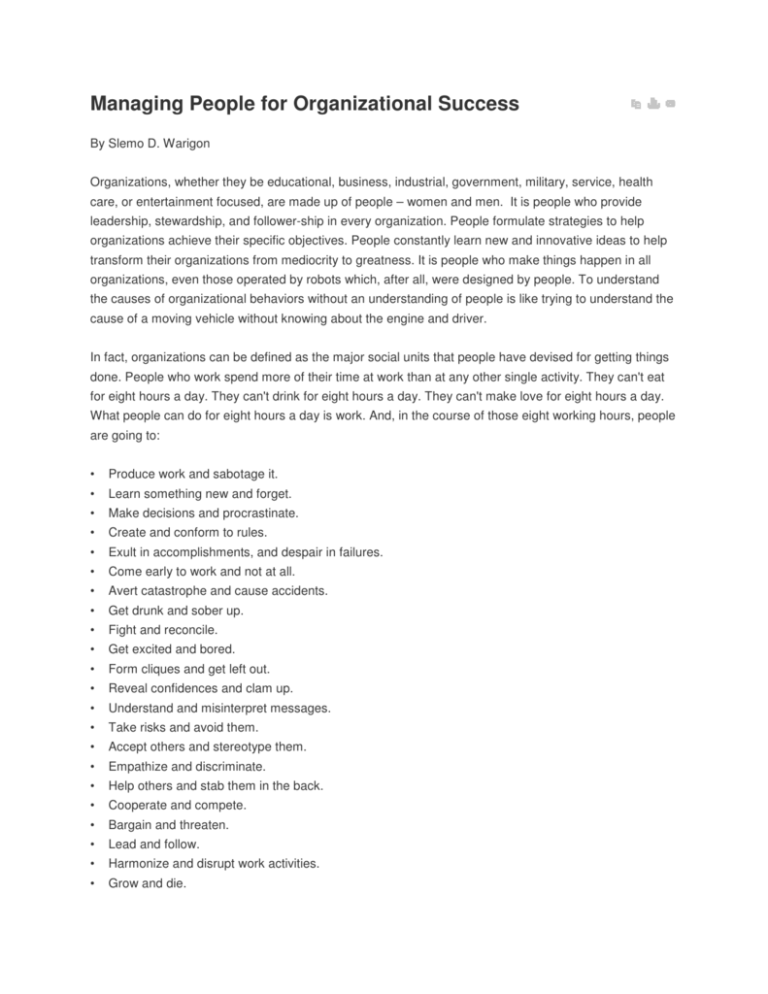
Managing People for Organizational Success By Slemo D. Warigon Organizations, whether they be educational, business, industrial, government, military, service, health care, or entertainment focused, are made up of people – women and men. It is people who provide leadership, stewardship, and follower-ship in every organization. People formulate strategies to help organizations achieve their specific objectives. People constantly learn new and innovative ideas to help transform their organizations from mediocrity to greatness. It is people who make things happen in all organizations, even those operated by robots which, after all, were designed by people. To understand the causes of organizational behaviors without an understanding of people is like trying to understand the cause of a moving vehicle without knowing about the engine and driver. In fact, organizations can be defined as the major social units that people have devised for getting things done. People who work spend more of their time at work than at any other single activity. They can't eat for eight hours a day. They can't drink for eight hours a day. They can't make love for eight hours a day. What people can do for eight hours a day is work. And, in the course of those eight working hours, people are going to: • Produce work and sabotage it. • Learn something new and forget. • Make decisions and procrastinate. • Create and conform to rules. • Exult in accomplishments, and despair in failures. • Come early to work and not at all. • Avert catastrophe and cause accidents. • Get drunk and sober up. • Fight and reconcile. • Get excited and bored. • Form cliques and get left out. • Reveal confidences and clam up. • Understand and misinterpret messages. • Take risks and avoid them. • Accept others and stereotype them. • Empathize and discriminate. • Help others and stab them in the back. • Cooperate and compete. • Bargain and threaten. • Lead and follow. • Harmonize and disrupt work activities. • Grow and die. These are productive and counterproductive human behaviors common in today's organizations. Surprisingly, people are often the most neglected part of critical organizational resources. People are being taken for granted, and in some cases, grossly mistreated by their superiors. It is not uncommon to find some leaders credited for organizational success, while their unfortunate subordinates are singled out as scapegoats for organizational failures. This is particularly true in an organization where the concept of accountability or stewardship is foreign to its leaders. Moreover, the art of motivating people in the workplace is increasingly becoming a lost art form. An organization is more apt to focus on enhancing its business systems rather than on motivating its employees to achieve significant improvements in business performance. This is particularly surprising in this era of information-based economy, knowledge management, and empowered workforce. How can this be possible? Are organizations slow in understanding that effective people management is a prerequisite for customer satisfaction and survival in an increasingly competitive global marketplace? How can organizations satisfy their external customers (buyers) if their internal customers (employees) are dissatisfied or unmotivated? Of course, we have heard it said numerous times by major organizations that people are their most important asset and that their strength is their people. These catchy phrases are bandied about by many organizations in their vision, their mission statements, and their annual reports. We also see them framed and hanging on the walls of our offices. Our leaders (senior management) repeat these statements in their communications to external stakeholders and employees. However, many of us are skeptical. Our cynicism is not accidental. We have heard it so often that we no longer believe it. How can our leaders continue to say these things while organizations continue to discriminate, downsize, lay people off, treat hard-working employees without a modicum of human dignity, and seemingly ignore the value of the people-side of the business? The rapidly changing nature of business given today's economy and global competitiveness requires a fundamental rethinking in how organizations manage people. Organizations will not be successful or profitable if they do not pay sufficient attention to their working people. Those people have faces. They have feelings. They have aspirations. They want to do their best every working day to help make their organizations successful. And, most importantly, they demand to be treated unfailingly as human beings. Thus, if you are a dedicated manager, leader, or business owner interested in improving your people management skills, you might find the following 21-point observations helpful: (1) You will always be working with people, regardless of your position or level in the organizational hierarchy. Even if you try to isolate yourself from others, chances are that you will find yourself constantly involved with people. (2) The knowledge that you will constantly be involved with people behooves you to constantly apply the Golden Rule in your dealings with people: treat people in the workplace as you would like to be treated. (3) Unhappy or dissatisfied employees contribute to the immediate downfall of virtually all organizations. Many organizations are finding that customer satisfaction is linked to employee satisfaction. Thus, to provide customer value and improve profitability or performance, your organizations must make sure that employees are generally satisfied with their jobs and organizational climate. (4) Employee satisfaction can only be achieved by creating and sustaining a motivating workplace. Motivation is inherently intrinsic – it emanates from within us. It does not work to bring in a motivational speaker from time to time to motivate employees – no matter how great that consultant might be. Employees today are better informed than ever before. They are too sophisticated for the quasimanipulative tactics that have worked for many traditional managers in the past. Employees want greater satisfaction from their work. They are rarely bought with money or artificial rewards alone. Employees want to do their jobs better when they love what they are doing! (5) To sustain motivation, organizations need to constantly identify, assess, and attack the de-motivators – those practices or activities that do not "turn on" the working people. Motivation requires organizations to set their employees on fire – inspiring them to be their best, to take risks, to think like entrepreneurs, and to unleash their limitless, synergistic potential. (6) People have strengths and weaknesses. It is too easy to de-motivate employees by harping on their weaknesses. Conversely, employees can get sufficiently motivated to do their best everyday when their strengths are appropriately recognized and used for the good of the organization. (7) The goal of every manager should be to help create a truly motivating organization – one that inspires each employee to do his/her best every day, especially when the manager is not looking. In this role, the motivating managers act as facilitator, trainer, coach, and relentless cheerleader. Also, the managers clearly understand the important responsibility of preparing employees for constant changes in their organization. (8) Factoring FUN into work helps in creating an environment conducive for highly motivated employees. Employees can become more complacent as their jobs become more routine and predictable over time. They can also become more distracted or less committed to their work when they feel the workplace is no longer fun. A good sense of humor for both managers and employees is vital to making the workplace more enjoyable and productive. (9) Do not try to "motivate" employees or treat them as your most "valuable assets" only when people are watching you. How you treat them in the confines of your office is just as important as how you treat them in public. Constancy of purpose is vital here. If employees sense differences in how they are being treated privately and publicly, they will not only distrust, but also lose respect for their leaders. This will create an organization where employees are more liabilities than assets. It de-motivates employees and leads to poor work performance. (10) Strategies, information systems, and business processes are just tools to help people (employees) perform their jobs better. Managers must have not only an understanding of such tools but also their impact on the people in the organization. Otherwise, the tools will not be effectively and efficiently utilized to help the organization achieve its goals. (11) The Ostrich Management Philosophy does not always work in organizations. Burying our heads in the sand of ignorance will not wish away major people-related problems in your organization. Taking the bull by the horns is the way to identify and solve such organizational problems. Otherwise, such problems persist to the extent that key employees start leaving your organization until it is eventually brought to its knees. (12) There is no substitute for direct, frequent and spontaneous interactions with people when it comes to understanding and solving organizational problems effectively. Relying on messages filtered or passed on by your favorite managers or cliques won't cut it. Chances are those select employees will just communicate what they think you want to hear – putting positive or negative spins on everything. Taking a reality check entails a direct connection to the people and reality in the workplace. (13) It is always helpful to practice what you preach. If you mistreat any employees, you can't realistically expect your subordinates to treat employees better. As a leader, your actions speak louder than words – setting the standard (example) for the treatment of employees throughout your organization. (14) Eliminate biased annual performance appraisals that reward "friends" and punish "enemies" in the workplace. Such a harmful practice promotes conflict, divisiveness, and bitterness among employees in your organization. Bitter or vindictive employees are usually the reason why most successful leaders or organizations are brought down from grace to grass. In the short run, such practice will please your already loyal colleagues, but in the long run they will adversely affect the loyalty and commitment of your employees overall. (15) Real people-oriented managers are those who spend more time honing their human relations skills than any other skills set. They realize that if they manage people poorly, their managerial careers will inevitably suffer gravely. They also understand that their legacies as leaders will be defined by the people they leave behind in the organization. (16) If you treat and motivate your employees well, your organization will not need a public relations office. Those highly motivated employees will be your best spokespersons to the outside world. They can make you look and smell good as leaders – helping build a solid legacy that is certain to last for generations. Conversely, you will need to invest heavily in your public relations office if you have a lot of unhappy employees who can damage your professional and organizational reputation. (17) The best advice one can give to any individual interested in a lasting, happy marriage is to always listen to one’s spouse. Similarly, the best advice one can give to a pragmatic manager interested in sustaining a productive working relationship is to always listen to his/her employees. By that I don't mean listening to just the few people who feel that their mission in life is to please you. Commitment to truth is essential here. This entails listening to both the pleasant and unpleasant truths in your organization. (18) Share the wealth. Give people full credit for organizational success. Find the time to communicate constantly with people on what is going on in your organization, not just when you have bad or negative things to say about people. Replace intimidation with inspiration in your people management philosophy. (19) Frequent reorganizations intended to eliminate people considered as “threats” to certain leaders are not good solutions to organizational problems. The enhancement of the work processes should be the focus of every reorganization effort, not the elimination of disliked people without good justification. (20) Make effective people management part of your strategic vision. Formulate specific and measurable objectives for achieving such a strategic vision. Report results on such objectives with transparent accountability. (21) Conduct ongoing assessment (internal audits) of your organization's people management practices. Be proactive and decisive in addressing known problems. In conclusion, creating a motivating organization can pose an incredible challenge for every leader or manager. We know that motivation leads to greater work performance in our organizations. We also know that managing or motivating people is an art. There is simply no magic formula or silver bullet for it. It comes with creativity, intuition, experience, stewardship, and steadfast faith in the goodness of people. It is up to you as a manager to create an environment in which your employees (people) know what is expected of them and feel passionate about doing their jobs – always putting the best of themselves in everything they do. Resources abound to help you meet this onerous challenge. Always remember that it's the people that drive your organization to succeed or fail. As long as you do not lose sight of this straight, unvarnished truth, you will be on the right path to building a truly people-based organization – one that requires managers to master the art of people management in order to be successful in the 21st century. There is no other route or detour to creating a high-performance organization. Organizational transformation from effectiveness to greatness starts with the recognition that the people are indeed your most important asset and deserve to be managed every day as such.





